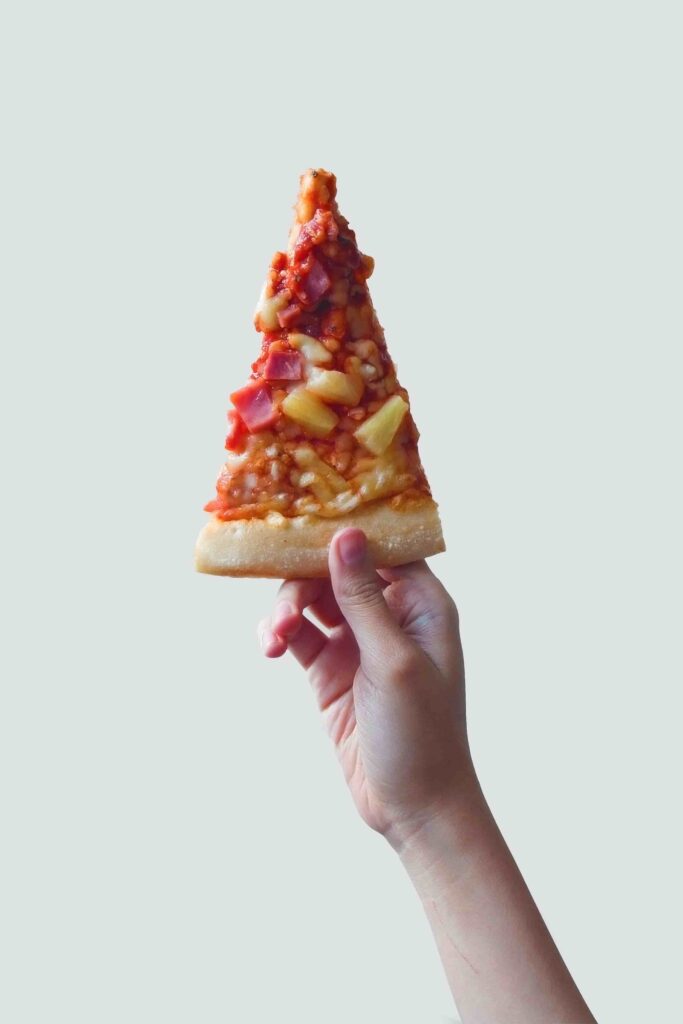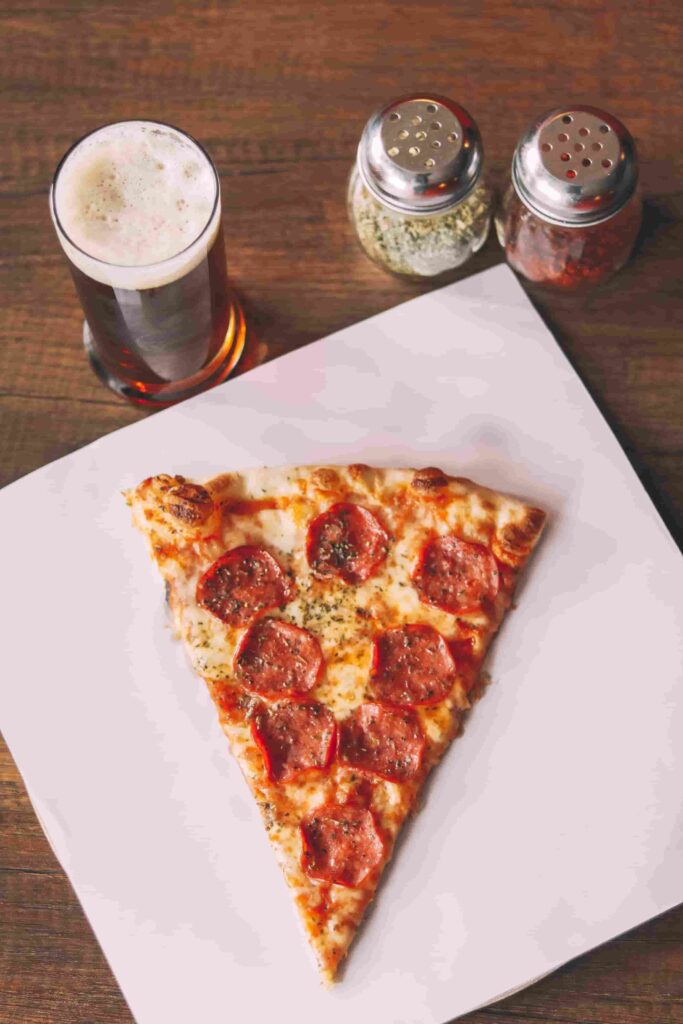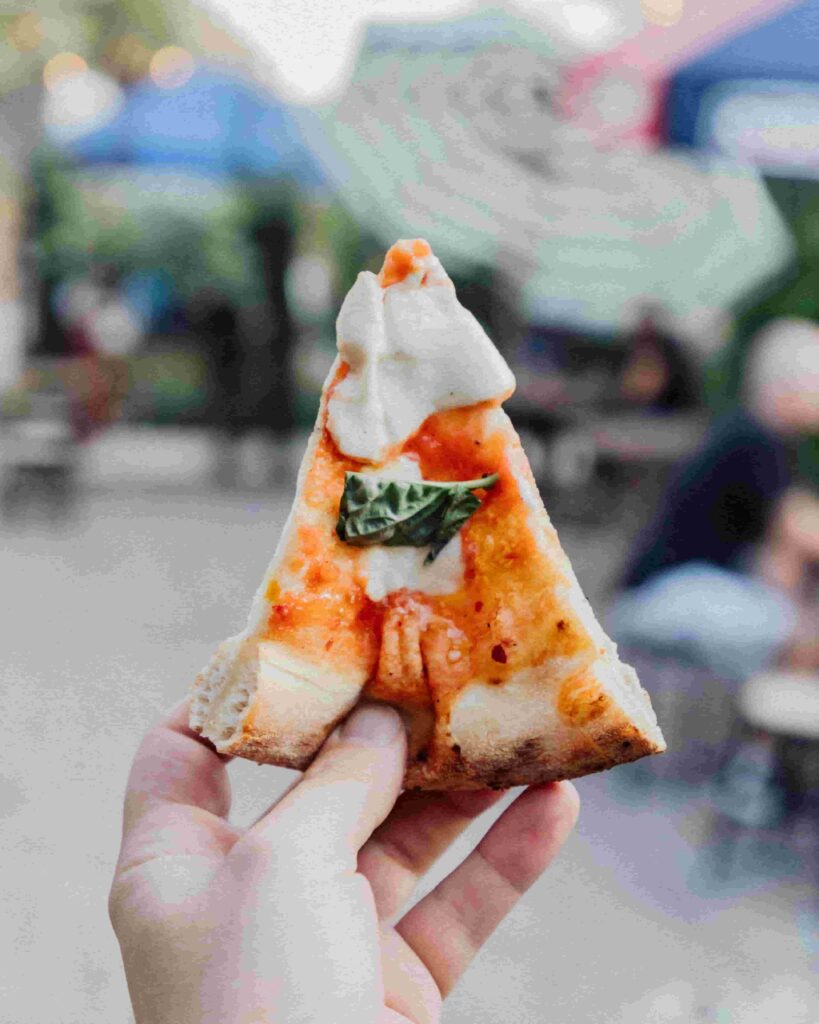For pizza lovers, the irresistible combination of dough, cheese, sauce, and toppings can be a source of joy and satisfaction. However, if you are conscious about your carbohydrate intake, you may wonder just how many carbs are in that delicious slice of your homemade pizza. Whether you’re a pizza enthusiast or simply seeking to make healthier choices, let’s uncover the secrets behind the carbs in one slice pizza.
In this article, we will go through the various factors that contribute to the carb content of pizza slices, examine the health implications of consuming carbs in pizza, and explore strategies for managing carb intake while still indulging in this beloved comfort food.
Carbs in one slice pizza

In general, Carbs in one slice pizza typically range between 20 to 30 grams of carbs, but this can vary based on crust type, size, and toppings. The carbs in one slice pizza vary based on crust type and toppings.
A thin crust slice might have 15-20 grams of carbs, a regular crust 20-30 grams, and a deep-dish slice over 35 grams. Toppings like vegetables and certain sauces can add more carbs.
1. The Crust: The Main Contributor
The crust is undeniably the most significant contributor to carbs in one slice pizza. Its content is primarily flour, which is rich in carbohydrates. The type of flour and the thickness of the crust play a pivotal role in determining the carb content:
- Thin crust: A slice of thin crust pizza has between 15-20 grams of carbs on average. However, if you’re indulging in a super-thin, crispy variety (like Neapolitan), the count could be a bit lower.
- Hand-tossed or regular crust: This common type typically contains about 20-25 grams of carbs in one slice pizza.
- Pan crust or deep-dish: Being thicker and denser, a slice from these pizzas can have anywhere from 30-40 grams of carbs.
- Alternative crusts: With health trends on the rise, many pizzerias now offer crusts made from almond flour, cauliflower, or other low-carb alternatives. These can significantly reduce carb content, sometimes to as low as 3-10 grams of carbs in one slice pizza, depending on ingredients and preparation.
2. The Sauce: A Sneaky Contributor
Pizza sauce, primarily made of tomatoes, is relatively low in carbs. However, many commercial sauces include added sugars, which can increase the carbs in one slice pizza. On average, the sauce contributes around 2-5 grams of carbs per slice. Opting for sauces with no added sugar can help keep this number low.
3. Cheese and Toppings: It Varies
Most cheeses used on pizzas – like mozzarella – have a minimal carb content, contributing less than 1 gram of carbs in one slice pizza. However, toppings can change the game:
- Vegetables: Veggies like bell peppers, onions, mushrooms, and olives add between 1-3 grams of carbs in one slice pizza.
- Meats: Most meats like pepperoni, sausage, and chicken are low in carbs. They might contribute negligibly to the overall count unless they have fillers or sweetened glazes.
- Fruit toppings: Pineapple, a popular pizza topping, is higher in sugar and thus can add around 2-3 grams of carbs per slice.
4. Additional Factors

- Serving size: Not all slices are created equal. The size of the slice and the total number of slices in a pizza can vary based on the restaurant or brand. Always check serving size when calculating carb count.
- Added ingredients: Some pizzas come with a drizzle of ranch, a sprinkle of cornmeal on the bottom, or stuffed crusts – all of which can affect the carb count.
In summary, estimating the number of carbs in one slice pizza isn’t straightforward. On average, a standard slice of a medium-sized, hand-tossed pizza might have around 25-30 grams of carbs. But this can swing in either direction based on the factors discussed.
For those tracking their carb intake, it’s always best to either check the nutritional information provided by the pizzeria or make homemade pizzas or Brooklyn style where you can control and measure ingredients. Regardless of its carbs in one slice pizza content, pizza is a delightful treat. If consumed mindfully and in moderation, it can fit into various dietary plans. So, next time you grab a slice, savor it without too much guilt, but with a tad more knowledge!
How to make pizza a low-carb?/ A healthier version
When someone is on a low-carb diet, enjoying a traditional slice of pizza can pose a challenge given its significant carbohydrate content, mostly from the crust. However, pizza lovers need not despair, as several low-carb pizza alternatives are both delicious and satisfying and have low carbs in one slice pizza. Here are some options:
1. Cauliflower Crust Pizza:
One of the most popular low-carb alternatives, cauliflower crust, offers a flavourful base with significantly fewer carbs in one slice pizza than traditional pizza crusts. Made by combining cauliflower rice with cheese, eggs, and spices, this crust can be a bit softer than traditional dough, but it’s delicious and pairs well with typical pizza toppings.
2. Almond Flour or Coconut Flour Crust
Both almond and coconut flour are low-carb alternatives to regular flour. By using these as the main ingredients, along with binders like eggs, you can create a more dough-like consistency that’s keto-friendly.

3. Meatza (Meat Crust Pizza):
For those not averse to a meaty base, ground chicken or turkey can be used as the ‘crust’ for the pizza. It’s protein-packed, grain-free, and very low in carbs. Once the meat is baked and firm, it can be topped with sauce, cheese, and preferred toppings.
4. Portobello Mushroom Caps:
Large portobello mushroom caps can act as the perfect mini pizza base. Their earthy flavor provides a rich background for traditional pizza toppings, and they’re naturally low in carbs.
5. Cheese Crust Pizza:
Another approach for the keto dieters out there is a crust made primarily of cheese, often parmesan or mozzarella. When baked, it turns crisp and golden, providing a crunchy base for toppings.
6. Eggplant Slices:
Thin slices of eggplant can be used as individual pizza bases. They can be grilled or baked until slightly tender before being topped and baked again until the cheese is melty and golden.
7. Zucchini Boat Pizzas:
Halved zucchinis can be scooped out slightly and filled with pizza sauce, cheese, and toppings. They’re a fun and veggie-packed way to enjoy the pizza flavors without the carbs.
8. Chicken Breast Pizzas:
Flatten chicken breasts and season them well. Once cooked, they can be topped with sauce, cheese, and toppings for a protein-packed, low-carb pizza experience.
Tips to make sauce and toppings low carbs:

- Sauce: Opt for sugar-free pizza sauce or make your own using crushed tomatoes, garlic, herbs, and a touch of olive oil.
- Cheese: Most cheeses are naturally low in carbs. Mozzarella, cheddar, feta, and parmesan are great choices.
- Toppings: Stick with low-carb veggies like bell peppers, olives, and spinach. For proteins, consider meats like pepperoni, sausage, and grilled chicken. Avoid sweetened or glazed meat toppings.
In conclusion, transitioning to a low-carb diet doesn’t mean you have to give up on pizza. It’s all about getting creative with the crust and being mindful of the toppings having minimum carbs in one slice pizza. With so many alternative crust options available, you can enjoy a guilt-free pizza night while sticking to your dietary goals!
Faqs
[sp_easyaccordion id=”3127″]
